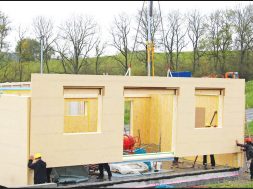An evolution with smart automation

The leading experts across the architecture industry have shared their views on smart technology and automation, highlighting the latest advancements, cutting-edge practices and sustainable technologies.
The rapid integration of smart automation and technologies in architecture is a double-edged sword, presenting challenges and opportunities. Adaptation and a proactive approach to learning and collaboration will be crucial for architects to thrive in this evolving landscape. Smart technologies enable architects to create innovative, dynamic designs that respond to real-time data and user needs. Buildings can be more adaptable and responsive, enhancing the overall user experience and environmental sustainability.
Automation in architectural practices is increasingly relying on real-time data sensing. This involves continuously monitoring and analysing data related to building systems, energy usage, and environmental conditions. Architects are incorporating sensors and monitoring devices to gather insights, enabling more informed decision-making in design and functionality. Shweta Kaw, Principal of Studio Meraki, contributed to the conversation by underscoring the creative freedom afforded by AI and its time-saving advantages in the fast-paced world of architectural practice. She further states, “These advancements not only streamline processes but also provide her with ample time for research and creative exploration”. She particularly highlighted the effectiveness of BIM and Parametric design, emphasising how they significantly reduce the challenges associated with manual management.
Architects are leveraging real-time data, sustainability considerations, and proactive anomaly detection to shape a future where automation is central to creating intelligent, responsive, and efficient built environments. Niraj Doshi, Founder & Principal of Niraj Doshi Design Consultancy, further expanded on the importance of data, aligning himself with Atul’s perspective. He emphasised that amidst the constant influx of data, the crucial skill lies in making informed decisions after thorough analysis.
Karan Desai, Founder & Principal Architect of Karan Desai Studio Architecture+Design, inquired about the impact of automation on using BIM in architectural planning. He expressed that BIM is gaining prominence, particularly in large-scale projects, as automation and technology are crucial in architectural construction and residential design. He highlighted the fascinating assistance these tools provide in creating project models. However, he also noted that the advancement of automation is currently more pronounced at the interior level and not yet fully realised on an architectural scale.
Automation in architectural practices is witnessing trends such as interior and lighting automation, expansion to the city level, real-time data sensing, AI in water consumption management, and early detection of anomalies. The industry is slowly but steadily adapting to these advancements, recognising their potential to revolutionise building design, construction, and operation.
In the ongoing discussion, Shweta shifted the focus to the trends in automation integration within architectural practices. She observed that while most automation practices are concentrated in interior and lighting, they gradually expand to the city level. Shweta highlighted the use of AI in water consumption and management with a mission to extend these technologies to rural areas.
Additionally, Ashish provided his viewpoint on home automation, emphasising its subjective nature and the varying levels of user acceptance. He acknowledged that some individuals may find automation inconvenient. Despite this, he highlighted the creation of modern designs in automation by leveraging technological advantages.
The future of automation in the architectural industry holds transformative developments, including increased integration of AI, generative design, sustainable and net-zero automation, enhanced collaboration between humans and machines, and the evolution of sophisticated digital twins. These advancements are expected to empower architects to create more innovative, efficient, and sustainable structures.
According to Atul Gupta, Head of Spatium Architects, Architects must delve into the practical aspects, asking about the current achievements and prospects of automation in architecture. Atul underscored the importance of data integration and leveraging available data to address building construction challenges. He firmly asserts, “Automation is the future, emphasising the need for architects to update and upgrade their skills to stay relevant continuously.”
Furthermore, Niraj emphasises the pivotal role of AI and smart technology as the initial steps toward promoting sustainability. He applauds the current development in automation, particularly its integration into sustainability efforts such as water conservation. He acknowledges that while there is still room for improvement in properly utilising these technologies, the significance and usage of smart technology continue to grow, with foundations already laid for its expanded application.
Moreover, Shweta underscores the importance of automation in the context of energy efficiency. She highlights how technology allows for proactive systems monitoring, preventing potential issues before they arise. Using meters equipped with sensors, artificial intelligence, and real-time monitoring and analysis, Shweta emphasises the necessity of these tools to gather data, enable informed decision-making, and ensure effective measures are in place.
Ashish introduced his proprietary Home Management System, combining home automation and building management seamlessly. This innovative system offers users a convenient and cost-effective means to manage their energy consumption. While the fundamental principles of home automation prioritise economic efficiency, convenience, and security, Ashish emphasises that a well-designed system can also significantly enhance energy efficiency. He highlights the incorporation of a cloud platform where data is automatically collected and analysed, providing residents with consumption graphs sent directly to their email.
29
Cookie Consent
We use cookies to personalize your experience. By continuing to visit this website you agree to our Terms & Conditions, Privacy Policy and Cookie Policy.










